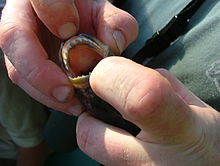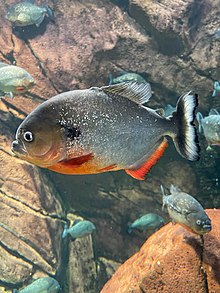Piranha
| Piranha Temporal range:
| |
|---|---|

| |
| A red-bellied piranha at the Karlsruhe Zoo | |
| Scientific classification | |
| Domain: | Eukaryota |
| Kingdom: | Animalia |
| Phylum: | Chordata |
| Class: | Actinopterygii |
| Order: | Characiformes |
| Family: | Serrasalmidae |
| Included genera | |
|
Catoprion | |
A piranha or piraña (
Etymology
The name originates from the indigenous Tupi people and their respective Tupi language. It is formed from two words, pirá meaning fish and sainha meaning tooth; the same word is used by Indians to describe a pair of scissors.[5] Another possible derivation is from pira nya, probably literally 'biting-fish'.[6] In the mid 18th century the Portuguese merged the word into piranha. Finally, the word may also come from the combination of pirá 'fish' and ánha 'cut' (which also meant 'bad' or 'devil' in Tupi-Guarani).[7]
Taxonomy and evolution
Piranhas belong to the family Serrasalmidae, which includes closely related omnivorous[8] fish such as pacus.[9] Traditionally, only the four genera Pristobrycon, Pygocentrus, Pygopristis, and Serrasalmus are considered to be true piranhas, due to their specialized teeth. However, a recent analysis showed, if the piranha group is to be monophyletic, it should be restricted to Serrasalmus, Pygocentrus, and part of Pristobrycon, or expanded to include these taxa plus Pygopristis, Catoprion, and Pristobrycon striolatus. Pygopristis was found to be more closely related to Catoprion than the other three piranha genera.[9]
The total number of piranha species is unknown and contested, and new species continue to be described. Estimates range from fewer than 30 to more than 60.[9]

Distribution
Piranhas are indigenous to the
Description
Size
Depending on the exact species, most piranhas grow to between 12 and 35 cm (5–14 in) long. A few can grow larger, with the largest living species, the
Morphology
Serrasalmus, Pristobrycon, Pygocentrus, and Pygopristis are most easily recognized by their unique
Biting abilities
Piranhas have one of the strongest bites found in bony fishes. Relative to body mass, the black piranha (Serrasalmus rhombeus) produces one of the most forceful bites measured in vertebrates. This extremely powerful and dangerous bite is generated by large jaw muscles (adductor mandibulae) that are attached closely to the tip of the jaw, conferring the piranha with a mechanical advantage that favors force production over bite speed. Strong jaws combined with finely serrated teeth make them adept at tearing flesh.[18]
Ecology

Piranhas vary extensively in ecology and behavior depending on exact species.[3] Piranhas, especially the red-bellied (Pygocentrus nattereri), have a reputation as ferocious predators that hunt their prey in schools. Recent research, however, which "started off with the premise that they school as a means of cooperative hunting", discovered they are timid fish that schooled for protection from their own predators, such as cormorants, caimans, and dolphins. Piranhas are "basically like regular fish with large teeth".[19] A few other species may also occur in large groups, while the remaining are solitary or found in small groups.[3]
Although popularly described as highly predatory and primarily
Piranhas lay their eggs in pits dug during the breeding season and swim around to protect them. Newly hatched young feed on zooplankton, and eventually move on to small fish once large enough.[22]
Relationship with humans



Piranha teeth are often used as tools themselves (such as for carving wood or cutting hair) or to modify other tools (such as sharpening of
Piranhas can be bought as pets in some areas, but they are illegal in many parts of the United States, and in the Philippines, where importers face six months to four years in jail, and the piranhas are destroyed to prevent proliferation.[26][27]
The most common aquarium piranha is Pygocentrus nattereri, the red-bellied piranha. Piranhas can be bought fully grown or as young, often no larger than a thumbnail. It is important to keep Pygocentrus piranhas alone or in groups of four or more, not in pairs, since aggression among them is common, not allowing the weaker fish to survive, and is distributed more widely when kept in larger groups.[citation needed] It is not uncommon to find individual piranhas with one eye missing due to a previous attack.
Attacks
Although often described as extremely dangerous in the media, piranhas typically do not represent a serious risk to humans.[3][28] However, attacks have occurred, especially when the piranhas are in a stressed situation such as the dense groups that may occur when the water is lower during the dry season and food is relatively scarce.[3][29] Swimming near fishermen may increase the risk of attacks due to the commotion caused by struggling fish and the presence of bait in the water.[30][31] Splashing attracts piranhas and for this reason children are more often attacked than adults.[29] Being in the water when already injured or otherwise incapacitated also increases the risk.[3] There are sometimes warning signs at high-risk locations[32] and beaches in such areas are sometimes protected by a barrier.[33]
Most piranha attacks on humans only result in minor injuries, typically to the
Reputation
Various stories exist about piranhas, such as how they can skeletonize a human body or cattle in seconds. These legends refer specifically to the red-bellied piranha.[40]
Piranha solution, a dangerous mixture of sulfuric acid and hydrogen peroxide known to aggressively dissolve organic material, draws its name from these legends surrounding the piranha fish.
A common falsehood is that they can be attracted by blood and are exclusively carnivores.[41] A Brazilian legend called "piranha cattle" states that they sweep the rivers at high speed and attack the first of the cattle entering the water allowing the rest of the group to traverse the river.[42] These legends were dismissed through research by Hélder Queiroz and Anne Magurran and published in Biology Letters.[43]
Accounts from Theodore Roosevelt
When former US President
See also
References
- . Retrieved 25 June 2009.
- ^ Froese, Rainer, and Daniel Pauly, eds. (2006). "Characidae" in FishBase. April 2006 version.
- ^ ISBN 978-0-520-04131-8.
- ^ a b BBC News Online (2 July 2007). "Piranha 'less deadly than feared'". Retrieved 2 July 2007.
- ^ Scientific American, "Fishing on the Amazon". Munn & Company. 6 November 1880. p. 293.
- ^ "Piranha | Origin and meaning of piranha by Online Etymology Dictionary".
- ^ Britton, A. Scott. Guaraní: Guaraní-English, English-Guaraní ; concise dictionary. New York: Hippocrene Books, 2005. Print.
- ^ Black-finned Pacu Fish, Colossoma macropomum Profile with care, maintenance requirements and breeding information for your tropical fish. Badmanstropicalfish.com. Retrieved on 13 May 2012.
- ^ . Retrieved 22 June 2009.
- ^ Fahrenthold, David A. (29 May 2005) "In River of Many Aliens, Snakehead Looms as Threat", The Washington Post.
- ^ Nico, L., Fuller, P. and Neilson, M. Piaractus brachypomus. USGS Nonindigenous Aquatic Species Database, Gainesville, FL. Revision Date: 23 August 2013.
- ^ Hanna, Jason (13 July 2012). "City cancels piranha bounty as other fish slaughtered". This Just In (blog). CNN Blogs. Archived from the original on 15 July 2012. Retrieved 8 March 2021.
- ^ Froese, Rainer and Pauly, Daniel, eds. (2018). Species of Pygocentrus in FishBase. March 2018 version.
- ^ Froese, Rainer and Pauly, Daniel, eds. (2018). Species of Serrasalmus in FishBase. March 2018 version.
- ^ "Pygocentrus piraya". piranha-info.com. Retrieved 25 March 2018.
- PMID 23259047.
- S2CID 86046546.
- PMID 23259047.
- ^ Red-Bellied Piranha Is Really Yellow New York Times (24 May 2003).
- ^ JSTOR 2388321.
- ISBN 978-0-517-67903-6.
- ISBN 978-0-937862-28-5.
- ISBN 978-0-89789-071-7.
- ^ Méthraux, A. (1948). "Tribes of Eastern Bolivia and the Madeira Headwaters". In Steward, J.H. (ed.). Handbook of South American Indians. Vol. 3. pp. 389, 402, 452.
- ^ Geiger, Diana Piranha as Pets – Exotic Pets. bellaonline.com
- ^ 5 arrested for selling piranhas in Philippines Archived 4 March 2016 at the Wayback Machine. Agence France-Presse. 12 March 2011
- ISBN 978-0-691-17074-9.
- ^ S2CID 84429161.
- ^ a b Mintz, Zoe (26 December 2013) Piranha Attack In Argentina Injures More Than 70, Fish Tore 'Bits Of Flesh' Off Swimmers On Christmas. ibtimes.com
- ^ a b "Ataque de piranhas deixa 15 feridos em 'prainha' no Rio Tietê". globo.com. 5 October 2009.
- ^ Martins, Kelly (16 November 2011). "Praia no Rio Paraguai tem quase um ataque de piranhas por dia em MT". globo.com.
- ^ a b "Net to take bite out of Brazilian piranhas". Herald Sun. 10 July 2007.
- ^ "Palmas registra 190 ataques de piranhas desde janeiro". globo.com. 16 July 2007.
- ^ "Balneário no Piauí recebe 100 mil peixes para conter ataque de piranhas". br.noticias.yahoo.com. 12 September 2011.
- ^ "Homem bêbado morre após ser atacado por piranhas na Bolívia". terra.com.br. 7 December 2011.
- ^ "Menina é atacada por piranhas e morre no Amazonas". tvuol.uol.com.br. 25 October 2012.
- ^ "Girl, 6, dies after piranhas eat her legs when canoe capsizes on family holiday". The Independent. 4 February 2015.
- ^ "Pirañas atacaron de nuevo, ahora en San Pedro: la víctima fue un hombre ahogado en el río Paraguay". La Nacion. 19 June 2022. Retrieved 4 January 2022.
- ^ "Piranhas vermelhas são medrosas e comem vegetais". EcoTerra Brasil. 2004. Archived from the original on 16 January 2011.
- ^ "Experimentos provam que peixes se agrupam para defesa, não para ataque". Ciência Hoje. 9 May 2005. Archived from the original on 6 September 2008.
- ^ Gonçalves, Alfredo J. (10 July 2007). "Boi de Piranha". Archived from the original on 8 January 2014.
- PMID 17148153.
- ^ Layton, Julia (30 June 2008). "Can piranhas really strip a cow to the bone in under a minute?". HowStuffWorks. Retrieved 22 May 2009.
- National Geographic. Archived from the originalon 1 November 2011. Retrieved 4 October 2012.
- ^ Robinson, Joe (22 November 2005). "Rumble in the jungle with Amazon's killer piranha". Los Angeles Times. Archived from the original on 31 August 2011. Retrieved 1 August 2009.
External links
- Piranha at Curlie
- Eric J. Lyman: "Piranha meat could take a bite out of what ails you", Houston Chronicle, 17 July 1998
- How to maintain healthy piranha in the home aquarium
- "Piranha Feeding Frenzy", National Geographic.com (2015-03-19)
